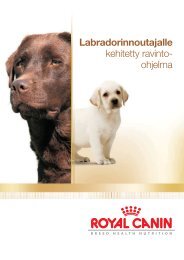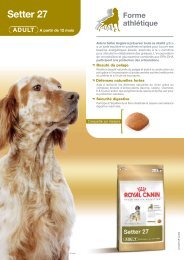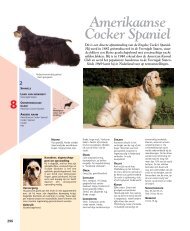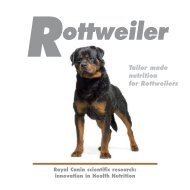The Great Dane - Breed Nutrition - Royal Canin
The Great Dane - Breed Nutrition - Royal Canin
The Great Dane - Breed Nutrition - Royal Canin
You also want an ePaper? Increase the reach of your titles
YUMPU automatically turns print PDFs into web optimized ePapers that Google loves.
A skeleton that requires special care<br />
throughout the <strong>Great</strong> <strong>Dane</strong>’s life<br />
Following a survey into the causes of mortality in dogs of particular breeds, osteoarticular lesions<br />
were found to be the cause in 65% of <strong>Great</strong> <strong>Dane</strong>s between 4 to 7 years and 42% of <strong>Great</strong> <strong>Dane</strong>s<br />
between 7 to 10 years. In this latter age group, the risk of osteoarticular pathology is 3.75 times<br />
greater in giant breeds compared with small breed dogs (Deeb & Wolf, 1994).<br />
As with many giant breeds, osteoarticular complaints are among the traditional <strong>Great</strong><br />
<strong>Dane</strong> pathologies. At 3-5 months a <strong>Great</strong> <strong>Dane</strong> puppy gains at least 1.5 kg a week<br />
(<strong>Royal</strong> <strong>Canin</strong> 2004). This means that nutritional errors have major consequences in<br />
this period of very intense development. But even when the growth stage is complete,<br />
it remains vital to give extra attention to the adult <strong>Great</strong> <strong>Dane</strong>’s skeleton to safeguard<br />
the dog’s well-being and maximise its life expectancy.<br />
Uchuaya des Terres axonaises<br />
© J.-M. Labat<br />
Elbow and hip dysplasia<br />
<strong>The</strong> <strong>Great</strong> <strong>Dane</strong> is one of the breeds at risk of developing elbow dysplasia: the first signs are<br />
crepitus and pain following hyperextension of the elbow.<br />
Hip dysplasia is a disease caused by excessive laxity of the head of femur in the acetabulum<br />
(socket). Although less at risk than Newfoundlands, Golden Retrievers or German Shepherds,<br />
<strong>Great</strong> <strong>Dane</strong>s are more than 60% more likely to contract hip dysplasia than the dog population as<br />
a whole (Lafond et al, 2002). Warning signs include an abnormal (‘rolling’) gait viewed from the<br />
rear, refusal to trot or jump and pain during flexion-extension of the hindlegs. A definitive diagnosis<br />
is obtained by X-ray.<br />
It is important that hip dysplasia is identified at the earliest opportunity:<br />
• for individuals: 40-50% of dogs suffering from hip dysplasia show no clinical signs if they are<br />
fed an appropriate diet from the earliest age and undertake appropriate physical exercise;<br />
• for the breed: genetic selection is at the core of the fight to eradicate this hereditary disease.<br />
Hip dysplasia<br />
In a dog suffering from hip dysplasia, the poor positioning<br />
of the joint surfaces leads to premature wear and tear and<br />
may result in the development of arthritic lesions that can<br />
be painful.<br />
14 15<br />
Stage 1 Stage 2 Stage 3<br />
1. Pelvis<br />
2. Head of femur<br />
3. Neck of femur<br />
4. Femur
















